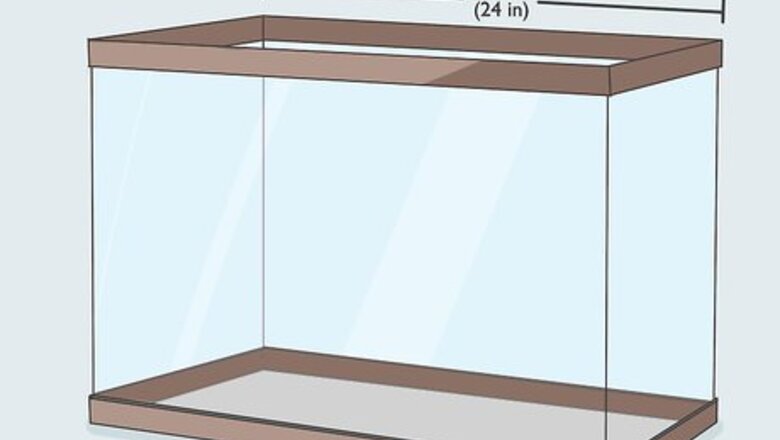
views
Creating a Stimulating Environment
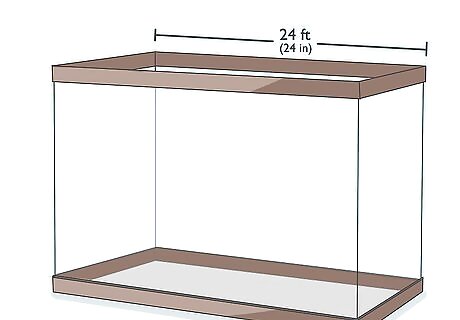
Pick out a tank that’s at least 2 ft (24 in) long. This may seem like a big tank if you have a tiny fish, but your fish actually needs lots of space for it to thrive and live healthily. Pick out a tank that’s 2 ft (24 in) for small fish, and an even larger tank if you have big fish. Look up your specific species of fish for information about the exact size of tank you should purchase. Little fish bowls are not big enough for fish such as bettas or goldfish. Set up your fish tank so it includes a filter, water heater, and treated water.

Fill the bottom layer of the tank with gravel or sand for the fish to dig around in. Sand and gravel comes in many different colors for fish tanks. Visit your local pet store to pick out a fish-friendly bottom layer for your fish to dig around in and enjoy. Purchase enough sand or gravel to cover the entire bottom of the fish tank in a thick layer.
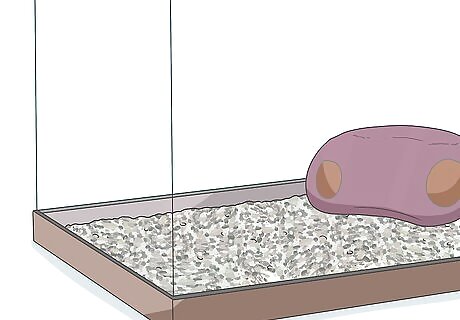
Provide tunnels or nooks for the fish to hide in. This helps stimulate a fish’s survival instincts by teaching them how to hide. Purchase little nooks or fish houses at your local pet store or online, or make your own using a PVC pipe or similar object. Before you put anything into the tank, wash it thoroughly with clean water to remove dirt or germs on the surface. However, don't use any detergents or dish soaps, as these can make your fish sick.

Place objects like fake plants in the tank to stimulate their brains. Fish love nibbling on plants and swimming around floating objects. Set a few small plants in your fish tank, settling them into the gravel or sand so they don’t fall over. Floating rocks are a nice addition to a fish tank because they'll love swimming around them. In saltwater aquariums you can add any shell or rock that came from the ocean after it has been cleaned in freshwater.
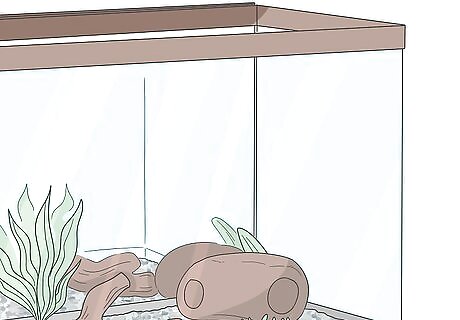
Add a mirror to the side of the tank for the fish to look at its reflection. Fish are fascinated by their reflection, and this is a great way to ensure your fish isn’t bored. Purchase a mirror specifically designed to go on the outside of a fish tank, or attach a reflective surface to your fish tank so it’s facing inwards towards the fish. If your breed of fish tends to get territorial, test its interaction with the mirror and remove the mirror if your fish seems agitated. Mirrors for fish tanks often attach using suction cups.
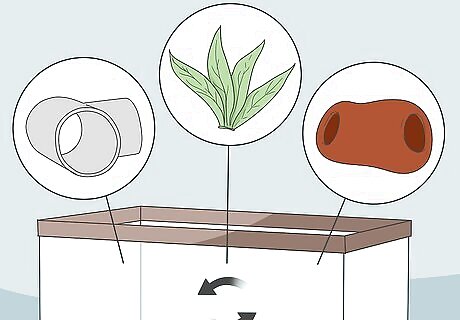
Switch out or add new objects every once in a while to keep the fish engaged. Even if your fish has awesome toys in its tank, it may become bored with them after a while. Every month or so, try to put a new object in the tank, or move the plants and other toys around so the fish has different surroundings. Keeping your fish engaged and interested in its tank will improve its mood and health.
Interacting with Your Fish
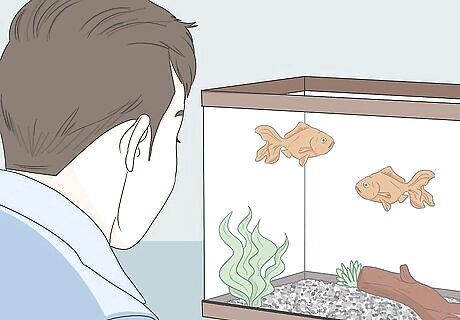
Spend time watching your fish to help you relax. Looking at fish has proven to help calm down the mind, having positive impacts on your mental wellbeing. Take some time to enjoy watching your fish swim around in its tank to help you destress.
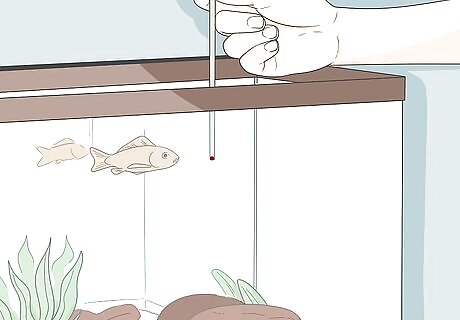
Train your fish to follow a target if it’s just getting to know you. Use your finger as the target, or use a small stick with a brightly colored end that will catch the fish’s attention. Give the fish a piece of food each time it comes to where the target is, moving the target around slowly once the fish gets good at following. This is a great way to teach your fish to swim through a hoop as well.

Teach your fish to jump out of the water for a cool trick. Fish such as bettas and goldfish can often do this trick. Wet your finger or a pointer stick and attach a piece of fish food to it, holding it just over the surface of the water. If your fish is hungry, it’ll try to reach the piece of food by jumping out of the water. Once your fish is able to grab the piece of food, keep raising your finger or stick higher above the water to make it more challenging. You may need to wiggle your finger or the stick above the water’s surface so your fish notices.
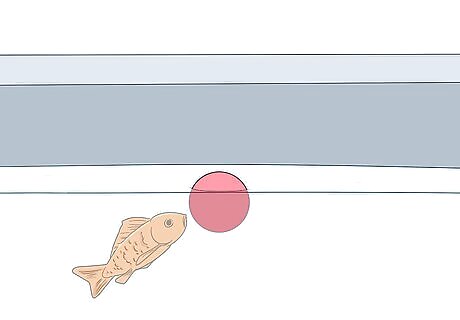
Encourage your fish to push a ball for a cute talent. Place a small floating ball, roughly the size of the fish’s head, in the fish tank. When the fish nudges it, give the fish a piece of food. Continue rewarding the fish with food whenever it touches the ball. Eventually, your fish will start nudging the ball harder to get a treat. Pay close attention to your fish when you're training it so you’re ready to give it a piece of food as soon as it touches the ball.
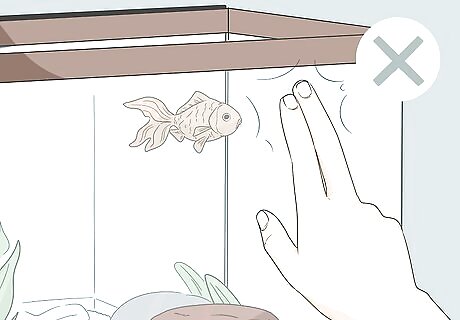
Avoid tapping on the glass to get your fish’s attention. This scares the fish and can bother their hearing abilities due to the sound. Use slow movements when trying to get your fish to notice you. Tapping on the glass will also likely make your fish hide.
Keeping the Fish Healthy
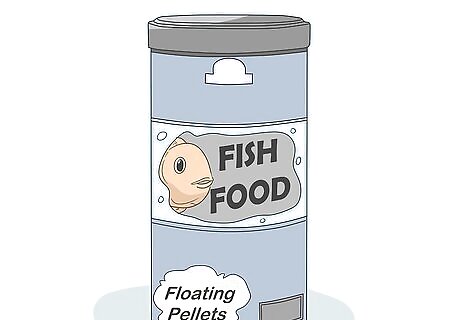
Feed your fish the right amount for its species and weight. This information is found on the label of a container of fish food that you would buy at a pet store or big box store. Fish can also eat small pieces of vegetables like peas or zucchini after they’re cleaned and blanched. Consider creating a chart to help you keep track of when to feed your fish.
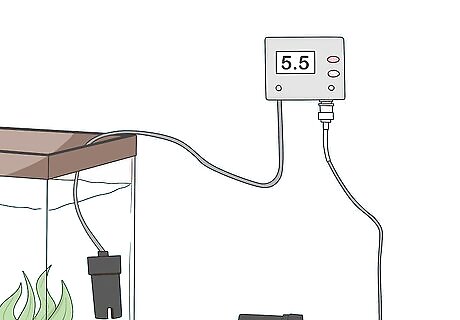
Test the water’s pH level each week using a kit. This will tell you if you have dangerous levels of ammonia, nitrate, or nitrite, meaning the water needs to be changed or treated. Water testing kits are easy to use and come with a chart to refer to so it’s clear what the pH level means. Follow the directions for your specific kit to help care for your tank. Purchase a water testing kit from your local pet store or online.

Use a gravel siphon to clean out the tank. The gravel siphon is placed into the tank overtop the gravel, sucking up the dirt and debris while cleaning the water. Because it’s a siphon, it’ll also be sucking out water. Unplug the filter and any other equipment before siphoning to avoid damaging them—they often don’t run well when there’s not enough water in the tank. Leave the fish in the tank while you’re cleaning the bottom layer of the tank.

Change 25% of the water out each week. As you’re using the gravel siphon, watch the water level to make sure you’re removing at least 25% of the water. This water will be replaced with new, fresh water—after it’s been treated with water conditioner, of course! Make sure the old water isn’t colder than the current water in the tank, using a thermometer to help you test the temperature. Refer to the bottle of water conditioner to see how much you need to pour in to the bucket of new water, stirring it using a fish net. Avoid removing more than 50% of the water from the tank because this messes with the pH levels too much. After finishing the water change, plug back in the filter and any other pieces of equipment.

Change the filter when it starts looking dirty. When you open up the top of the water filter, pull the filter out to see if it's covered in dirt and grime. If so, it's time to change it. Another way to decide if it's time for a new filter is to look at the water flow. If the water has slowed down, the filter needs to be changed. Avoid changing the filter on the same day you change the water because this takes out too much beneficial bacteria.


















Comments
0 comment